Abstract
Pulsed laser sources operating in the spectral range of 1.8 to 2.1 μm draw considerable attention due to their wide range of practical applications in many areas, including medicine, sensing, materials processing, etc. In this work, we propose a pulsed Tm-doped fiber laser scheme operating in the 2 μm spectral region with pulsed pumping at 1.57 μm. The pump source consisted of a series-connected Er-Yb pulsed master oscillator and an EDFA emitting ∼400 μs pulses with an energy of 9.3 mJ. Using this setup, we made a Tm-doped fiber laser that provided 2 mJ pulses in the 2 μm spectral region with a slope efficiency of 28% from pulses at 1.57 μm.
1. Introduction
The emission range between 1.8 and 2.1 μm is of great interest for a range of practical applications, including medicine and materials processing, atmospheric sensing, lidar, pump sources of longer-wavelength lasers, spectroscopy, metrology, and scientific applications. Despite the long period of time that has passed since the first thulium-doped fiber laser was developed [1], and the huge number of works published on this topic (see, for example, ref. [2] and references therein), there remains ongoing interest in this field, and new works are regularly published in which the authors continue to improve various parameters of these lasers, such as the average power, pulse energy, and efficiency. This is due to two main factors, namely an increase in the number of possible applications of these lasers and an increase in the requirements for their parameters, as well as the improvement of laser elements (including the active medium; optical fibers; pump sources for which LDs or other fiber lasers are used, for example, Er, Er-Yb and Raman converters [3,4,5,6]; and the optimization of the design of optical cavities).
Some applications may not require high average power, a high repetition rate, or ultrashort pulses, but may require high energy in a pulse of relatively long duration—from 100s of ns to 10s of μs. In addition, not all applications require high beam quality, for example, lithotripsy [7] and some atmospheric or earth surface sensing applications. In these cases, the solution to the problem of optimizing the active medium and the resonator circuit may differ significantly from the options usually used when optimizing efficiency for high average power or when it is necessary to achieve good beam quality.
For applications requiring high pulse energy, without the need for high average power, one of the optimization options is to minimize the required diode pumping power while maintaining the pulse energy, since laser diodes still account for a significant part of the cost of the overall laser system. In this case, an increase in cost efficiency can be achieved by using an active medium with the maximum metastable level lifetime. For silica-based optical fibers, commonly used for the wavelength range under consideration, the ion with the longest metastable state lifetime is Er3+. The level lifetime of 4I13/2 is about 10 ms, which is approximately an order of magnitude longer than the lifetime in Yb ions, and ∼20–30 times longer than that of Tm ions at the metastable level.
In this work, we investigated the possibility of using multimode Er-doped fiber with core diameter of 110 μm for the effective storage of low-power pump radiation from multimode laser diodes at 975 nm and amplification to high-energy-level laser pulses at 1568 nm. These pulses, in turn, were used for the pumping of a double-clad Tm-doped fiber laser (TDFL). This laser operated in a free-running regime and generated pulses with 2 mJ energy with a total pulse duration of up to 400 μs and a repetition rate of ∼50 Hz. The pulse duration of the TDFL can be shortened down to ∼20 μs if an active or passive modulator is introduced in the cavity. Further reduction in pulse duration will require an appropriate increase in fiber core size due to the fiber damage threshold limitation. These results show the principal possibility of using low-power pump sources for the generation of high-energy pulses with a low repetition rate.
2. Principles
The idea of this experiment is to obtain as many energetic pulses as possible at ∼2 μm with the minimum pump power involved. Typically, the laser pulse energy is related to and can rarely exceed the energy stored in the active medium, unless the laser pulse duration is much longer than the active ion lifetime at the upper laser level. Since the regular lifetime of a Tm ion in the excited state is rather short (∼400 μs), exciting a Tm-doped active medium requires high-power pumping sources. Obviously, this requirement is relevant regardless of the required pulse repetition rate. However, we can improve the situation if we pump a Tm laser with another pulsed source based on a medium with a much longer lifetime, which means a lower requirement for pump power. That is why we decided to build an Er pulsed laser as a pump source for the Tm-doped fiber laser. The lifetime of Er in a phosphosilicate glass matrix reaches 10 ms, which significantly exceeds the lifetime of Tm in any matrix. Taking into account all of the above, the proposed method seems promising. The scheme of the laser is presented in Figure 1. The setup consists of a chain of three separate fiber optic devices. The pump source of the Tm-doped fiber laser is a master oscillator power amplifier scheme based on an Er-doped fiber amplifier and an Er-Yb-doped fiber master oscillator.

Figure 1.
Schematic of the laser.
3. Results and Discussion
3.1. Er-Yb-Doped Fiber Master Oscillator
We used a home-made Er-Yb fiber for the master oscillator based on a phosphosilicate matrix doped with Er and Yb (a commercially available fiber with similar parameters is Coherent (Nufern) SM-EYDF-6/125-XP). The length of the fiber used was approximately 10 m. The diameter of the fiber core of 6 μm and the refractive index difference between the core and the first cladding of 0.014 corresponded to a high-order mode cut-off wavelength near 1550 nm. A classic Fabry–Perrot cavity with a pair of fiber Bragg gratings (FBGs) as reflecting mirrors and active fiber in the middle constituted the laser. The oscillator operated in a single-mode regime, which is vital for stable operation. It is worth noting that the fiber had a double cladding (DC) structure with a reflective outer polymer coating providing light, which was guided through the first cladding. This is necessary for pumping with multimode laser diodes (LDs). For this experiment, a fiber-coupled LD operating at 980 nm and emitting a maximum of 12 W radiation power was used. To make the laser operate in pulsed mode, we modulated the radiation of the pumping LDs [8]. This method is convenient when the required pulse duration is rather long, longer than transient processes in the cavity preceding lasing. Additionally, this approach gives versatility in terms of pulse duration and period. In our experiments, we varied the pulse duration in the range of 300–6000 μs. Obviously, the most efficient pulse duration for the pumping of a Tm-doped fiber laser should be several times shorter than the Tm metastable level lifetime. Excitation with longer pulses would compete with spontaneous transitions to the ground state and would not contribute much to the energy stored in the medium and, therefore, to the pulse energy. The repetition rate of the pulses was set to 50 Hz. A sufficiently low frequency was chosen to ensure that the active medium, in particular, that of the Er-doped fiber amplifier (EDFA) described below, had time to recover. The pulses emitted by the Er-Yb laser were launched into the amplifier (Figure 1), which was intended to scale the pulse energy.
3.2. Er-Doped Fiber Amplifier
The scaling value is related to the energy stored in the active medium. For a given active ion concentration, the stored energy is proportional to the volume of the active medium. Therefore, for the amplifier, we developed an MM Er-doped fiber with an increased core diameter of 110 μm. The Er concentration was chosen to achieve highest possible efficiency without ion clustering [9]. The preform of the fiber was fabricated with a standard MCVD technology. The outer diameter of the glass cladding was ∼150 μm (Figure 2a). To obtain a larger core, the Er-doped fiber preform was subjected to additional procedures. The preform was successively etched and compressed lengthwise. Although the procedure allows us to significantly increase the core area, there are some drawbacks. In particular, the core shape evolves along the fiber, and the position of the core relative to the outer cladding also changes. To minimize additional deformations, the fiber was drawn at lowered temperature. The fiber supported light-guiding through the first cladding in the same manner as for the Er-Yb-doped fiber. To provide better mode mixing and pump absorption, the cladding was shaped into an octagon. We measured two absorption spectra of the fiber when the light propagated through the core and the cladding (Figure 2b). It is easy to see that the ratio between the core and the cladding absorption spectra was close to 2, which is equal to the ratio of the inner cladding and the core area that indicates good mode mixing in the fiber inner cladding. The length of the Er-doped fiber used was ∼8 m. For pumping the amplifier, we used a pair of MM LDs at 980 nm. With a multimode pump combiner (MMPC), we combined the pump and the signal from Er-Yb-doped fiber seed laser.
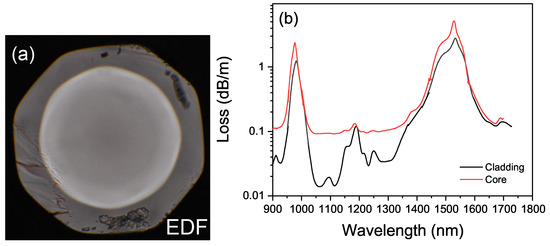
Figure 2.
Image of Er-doped fiber cross section (a). Core and cladding absorption of Er-doped fiber (b).
The amplifier was pumped in a CW regime with a forward pumping scheme that resulted in some residual pump radiation appearing at the output. Therefore, we used a pump stripper to eliminate the pump radiation propagating through the fiber cladding. The result of the pulse amplification is depicted in Figure 3a. The envelopes were measured with a 1 GHz LeCroy WavePro 7100 oscilloscope. Initially, the pulses had a rather rectangular shape (corresponding to a zero-pump power line). However, as the pump power increased, the head of the pulse started receiving more energy from the active medium than the tail. The result is characteristic of the depletion of stored energy. In order to evaluate the pulse energy, we measured the signal power at the output. However, a significant part of the output power corresponded to the amplified spontaneous emission (ASE). Therefore, we also calculated the ratio between the ASE and the pulses according to the oscilloscope envelopes of the output signal. A close-up of the envelope data is shown in Figure 3b. The intensity levels before the zero timestamp and after ∼1 ms correspond to the ASE only. The ASE level changes with time due to its relation to the population inversion of the medium. Thus, we can conclude that the population inversion, which means the stored energy, is significantly depleted when the pulse passes through the medium. It is also evident that the population inversion of the active media is completely restored in ∼4 ms at a pump power of ∼29 W. This means that we can increase the repetition rate to ∼200 Hz without losing pulse energy. The ASE was the main factor that limited the amplification of the pulses.
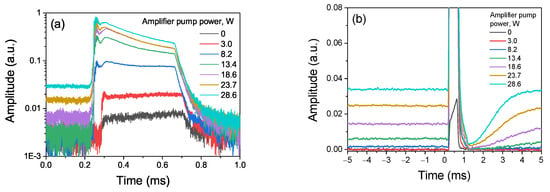
Figure 3.
Pulse envelopes at the output of the amplifier at various pump powers and different scales. Close-up of the envelopes (a) and the envelopes focused on the ASE level (b).
In Figure 4a, one can see how the two components grow with pump power. When the pump power reaches ∼29 W, the contribution of ASE overtakes the pulse power. Moreover, since the ASE gains power faster than the pulses, further pump increase is not as efficient for the pulse amplification. Thus, the maximum energy we managed to achieve was as high as 9.3 mJ. This is close to the value of 7.5 mJ that was obtained in [10] in Er-doped fiber with a core size of 90 μm, but our pulse duration was intentionally much longer, which may have provided an additional (∼10 %) increase in pulse energy due to the continuous pumping of the EDFA.
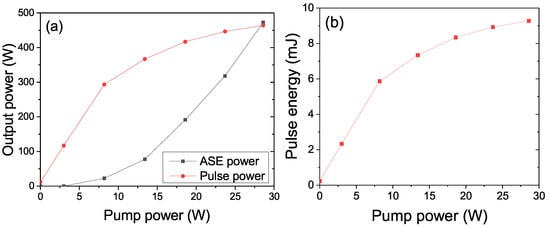
Figure 4.
ASE and pulse power (a) and pulse energy (b) at the output of the EDFA for different pump powers.
3.3. Tm-Doped Fiber Laser
The pulses were directed to the Tm-doped fiber (TDF) via an MMPC, as shown in Figure 1. The fiber was also of the DC type. The cladding absorption spectrum of the TDF is shown in Figure 5a. The absorption at 1.57 μm was about 1.6 dB/m, which, with a fiber length of 11 m, corresponds to 17.6 dB of small-signal absorption through the inner cladding. The fiber core diameter was 15 μm, which, along with the MMPC with a single-mode signal fiber, provided a single-mode regime of operation at 2.0 μm. The glass cladding was 125 μm. The TDFL cavity was formed of two right-angle cleaved ends of the active fiber and the input signal port of the MMPC (see Figure 1).
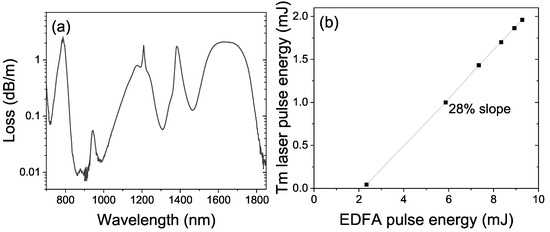
Figure 5.
Cladding absorption of Tm-doped fiber (a). Tm-doped fiber laser pulse energy depending on pumping pulse energy (b).
In the described laser configuration, we achieved pulsed lasing in a typical gain-switched regime of operation. The laser operated at a wavelength longer than 2 μm, which is beyond the operating range of our spectrometers. Nevertheless, using interferometric filters and band pass mirrors, we measured the TDFL output power and oscilloscope envelopes. The TDFL pulses were derived from two ends. Since the splicing loss of the MMPC signal fiber and TDF is very low (due to the proximity of the MFD of the fibers used in a spectral range around 2 μm), the pulse energy at these two outputs is quite close. The dependence of the total pulse energy at 2 μm from both cavity ends on pumping pulse energy is presented in Figure 5b. The laser generates with a threshold energy of ∼2.1 mJ at 1.57 μm. The laser slope efficiency is ∼28%. Figure 6 shows normalized oscilloscope envelopes of the output pulses and pump pulses. From the figure, one can see that there is a slight time delay between he pump and signal pulses. The more energetic the pump pulses, the shorter the delay. The delay duration is related to the population inversion in the active medium, its gain and the generation conditions. The more energetic the pump pulses we use, the faster we reach the required gain level for lasing. The TDFL initiates operation with several equally spaced pulses, and their period shortens as the pumping pulse energy grows. The nature of the fine structure of the pulses in the TDFL is more complicated. Their period is sensitive to the pump pulse amplitude. The amplitude of each pulse is not the same. Therefore, the fine repetition rate is not regular. The repetition rate of the bunches is equal to 50 Hz, which is set by the pump pulses. In general, the pulsing behavior is similar to that of the Er-Yb laser described above. These pulses are typical relaxation oscillations, which precede the CW regime of lasing. In addition, in both lasers, the pulsing gradually turns into CW lasing, which is interrupted as soon as the pumping ends. This means that if one needs to shorten the pulse duration at 2 μm down to 1μs or shorter, there are two options. The first option is to increase the stored energy in the Tm-doped fiber and also shorten its length, which, in turn, requires a corresponding increase in the active fiber core size. Another option is to shorten the pulse duration of the pump at 1570 nm down to 1–2 μs. This will lead to the corresponding shortening of pulses at 2 μm in the quasi-continuous-wave regime. To achieve this, we plan to use in the next stage of this work an active modulator in the EDFA instead of pulses from the Er-Yb laser and Tm-doped fiber with an increase in the size of the core. This increase is also important due to damage limitation, which requires a >25 μm core diameter for pulses with 2 mJ energy and a pulse duration of ∼1.5 μs.
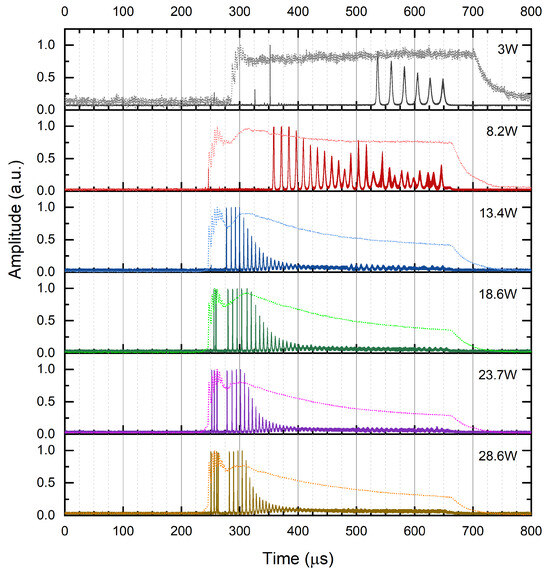
Figure 6.
Oscilloscope envelopes of amplified pulses of the EDFA (dotted lines) and lasing pulses of the TDFL (solid lines) for different pump powers of the EDFA (the pump value is in the right upper corner of the panels).
According to the presented results, our system can extract pulses with an energy of 1.5 mJ at 2.0 μm with a pump power as small as 12.5W at 980 nm. This value of output energy is selected because at this point, the ASE power in the EDFA is still small and the power conversion efficiency is the highest. If we compare our results with other works (see, for example, [11]) in which the authors obtained a similar pulse energy in TDFL with ∼50 W of pump power at 1692 nm or ∼110 W of pump power at 793 nm, we see that in our work, the required pump power is 5 to 10 times lower. The drawback of this scheme is low average power and a low repetition rate. However, this is not important for some applications. Finally, our results show the possibility of achieving a pulse energy of 100 mJ at 2.0 μm with only ∼800 W of pump power by only scaling the core sizes of our fibers. Additionally, in the case of an increase in the power conversion efficiency for TDFs from relatively low value of 28% to a typical value for such systems, 50–60%, we can expect an additional reduction in the required pump power to a level of ∼400 W.
4. Conclusions
In summary, using ∼40 W pump power, we developed a pulsed laser system operating at 1.57 μm, emitting 9.2 mJ pulses. Using the setup as a pumping source of a Tm-doped fiber laser, we obtained 2 mJ pulses in the 2 μm spectral region with a slope efficiency of 28% from EDFA pulses. While the achieved pulse energy is far from recorded one, we believe that the proposed approach can give a lot of benefits in terms of pumping efficiency and cost efficiency. The results obtained can be very useful if scaled to higher energy (∼100 mJ) with the aid of larger core Er- and Tm-doped fibers. Such laser sources may find numerous applications, for example, in lithotripsy, where high pulse energy and low average power are required. Further work will aim to optimize the active and passive fibers of the setup and further increase the pulse energy at 1.57 and 2.0 μm, as well as shortening the pulse duration to the range of 1–2 μs.
Author Contributions
Conceptualization and methodology, M.M.; investigation, A.K., S.F., K.R., D.L. and M.M.; data curation, A.K.; writing—original draft preparation, A.K. and M.M.; writing—review and editing, A.K., S.F., K.R., D.L. and M.M.; supervision, M.M. All authors have read and agreed to the published version of the manuscript.
Funding
This work was supported by the Center of Excellence “Center of Photonics” funded by the Ministry of Science and Higher Education of the Russian Federation under Contract 075-15-2022-315.
Institutional Review Board Statement
Not applicable.
Informed Consent Statement
Not applicable.
Data Availability Statement
The data are contained within the article.
Conflicts of Interest
The authors declare no conflicts of interest.
References
- Hanna, D.; Jauncey, I.; Percival, R.; Perry, I.; Smart, R.; Suni, P.; Townsend, J.; Tropper, A. Continuous-wave oscillation of a monomode thulium-doped fibre laser. Electron. Lett. 1988, 24, 1222–1223. [Google Scholar] [CrossRef]
- Geng, J.; Wang, Q.; Lee, Y.; Jiang, S. Development of Eye-Safe Fiber Lasers Near 2 μm. IEEE J. Sel. Top. Quantum Electron. 2014, 20, 150–160. [Google Scholar] [CrossRef]
- Tang, Y.; Xu, L.; Yang, Y.; Xu, J. High-power gain-switched Tm3+-doped fiber laser. Opt. Express 2010, 18, 22964–22972. [Google Scholar] [CrossRef] [PubMed]
- Simakov, N.; Hemming, A.; Bennetts, S.; Haub, J. Efficient, polarised, gain-switched operation of a Tm-doped fibre laser. Opt. Express 2011, 19, 14949–14954. [Google Scholar] [CrossRef]
- Jiang, M.; Tayebati, P. Stable 10 ns, kilowatt peak-power pulse generation from a gain-switched Tm-doped fiber laser. Opt. Lett. 2007, 32, 1797–1799. [Google Scholar] [CrossRef] [PubMed]
- Lenski, M.; Heuermann, T.; Wang, Z.; Aleshire, C.; Gaida, C.; Jáuregui, C.; Limpert, J. In-band pumped, Q-switched thulium-doped fiber laser system delivering 140 W and 7 mJ pulse energy. Opt. Lett. 2024, 49, 4042–4045. [Google Scholar] [CrossRef] [PubMed]
- Kochiev, D.G.; Naryshkin, S.A.; Teodorovich, O.V.; Shcherbakov, I.A. Methods and technologies of photonics in endosurgery. Opt. Spectrosc. 2015, 119, 398–403. [Google Scholar] [CrossRef]
- Han, D.; Chen, Y.; Guo, R.; Zhang, B.; Li, T.; Ren, K.; Zheng, Y.; Zhu, L.; Liang, L.; Hui, Z. Q-switched mode-locked fiber laser based on the pump modulation technique. Infrared Phys. Technol. 2024, 137, 105210. [Google Scholar] [CrossRef]
- Kotov, L.V.; Aleshkina, S.S.; Khudyakov, M.M.; Bubnov, M.M.; Medvedkov, O.I.; Lipatov, D.S.; Guryanov, A.N.; Likhachev, M.M. High-Brightness Multimode Fiber Lasers for Resonant Pumping. J. Light. Technol. 2017, 35, 4540–4546. [Google Scholar] [CrossRef]
- Khudyakov, M.M.; Levchenko, A.E.; Velmiskin, V.V.; Bobkov, K.K.; Aleshkina, S.S.; Zaushitsyna, T.S.; Bubnov, M.M.; Yashkov, M.V.; Guryanov, A.N.; Kotov, L.V.; et al. Narrow-Linewidth Diffraction-Limited Tapered Er-Doped Fiber Amplifier with 2 mJ Pulse Energy. Photonics 2022, 9, 933. [Google Scholar] [CrossRef]
- Lenski, M.; Heuermann, T.; Wang, Z.; Aleshire, C.; Gaida, C.; Jáuregui, C.; Limpert, J. Highly efficient, in-band pumped, thulium-doped, Q-switched fiber laser. In Fiber Lasers XXI: Technology and Systems; Jollivet, C., Ed.; International Society for Optics and Photonics, SPIE: Bellingham, WA, USA, 2024; Volume 12865, p. 128650T. [Google Scholar] [CrossRef]
Disclaimer/Publisher’s Note: The statements, opinions and data contained in all publications are solely those of the individual author(s) and contributor(s) and not of MDPI and/or the editor(s). MDPI and/or the editor(s) disclaim responsibility for any injury to people or property resulting from any ideas, methods, instructions or products referred to in the content. |
© 2025 by the authors. Licensee MDPI, Basel, Switzerland. This article is an open access article distributed under the terms and conditions of the Creative Commons Attribution (CC BY) license (https://creativecommons.org/licenses/by/4.0/).